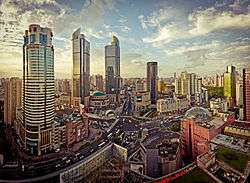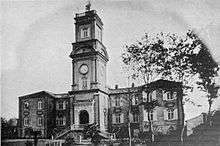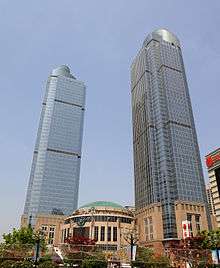Xujiahui
| Xujiahui | |||||||||||
 Central shopping district of Xujiahui | |||||||||||
| Simplified Chinese | 徐家汇 | ||||||||||
|---|---|---|---|---|---|---|---|---|---|---|---|
| Traditional Chinese | 徐家匯 | ||||||||||
| Literal meaning | Xu family junction | ||||||||||
| |||||||||||
Xujiahui, also spelt Zikawei or Ziccawei from Shanghainese, is a locality in Shanghai, China. It is a historic area of commerce and culture administratively within Xuhui District, which is named after the locality.[1] The area is a well-known precinct for shopping and entertainment in Shanghai. It is served by the Xujiahui Station of the Shanghai Metro.
Name

Xujiahui literally means "Xu's junction" - or, more precisely, "property of Xu family at the junction of two rivers" in Mandarin.[2] The "Xu family" refers to the family of Xu Guangqi (1562–1633), China's most notable Catholic convert. Most of what is now Xujiahui was once the ancestral home of the Xu family. Baptized by famed Italian Jesuit, Matteo Ricci, Xu Guangqi and his descendants donated large plots of land to the Catholic Church, including the site of the St. Ignatius Cathedral.

Pronounced in the Shanghainese dialect of Wu Chinese, it is called "zi-ga-wei". During the 18th century it was known by Shanghai's western residents as "Ziccawei" or "Siccawei" (English) or "Zikawei" or "Zi-ka-wei" (French). These names survive in the names of some institutions, such as the Bibliotheca Zi-Ka-Wei, and the area is still listed in a number of contemporary guidebooks and literature as "Zikawei" or some variant thereof.
History



With land donated by Xu Guangqi's family and those acquired by other means, the Society of Jesus established a grand cathedral as well as an entire one square mile complex that covers most of present-day Xujiahui. In addition to the cathedral, the French Jesuits also built orphanages, monasteries, schools, libraries and the Xujiahui observatory (now the Shanghai Bureau of Meteorology).
In time to become the stronghold of Catholics in East Asia, one of the first structures to be built by the Jesuits was the St. Ignatius Cathedral in 1847, later reconstructed in 1906. The Cathedral is located on what is now known as North Caoxi Road and is still referred to in English as the St. Ignatius Cathedral. The sign on the street calls it simply "Catholic Church." The cathedral was featured in the opening scenes of Steven Spielberg's 1987 film Empire of the Sun.

A number of other structures survive from its days as a centre of Catholicism. One is Xuhui College on 68 Hongqiao Road, now renamed Xuhui High School (or Xuhui Middle School). Established by Jesus in 1850, Xuhui (St. Ignatius) College was the first educational institution in China to offer a fully western curriculum. Another is the Bibliotheca Zikawei (or Bibliotheque de Mission), now a branch of Shanghai Library, adjacent to the cathedral. Several of the convent buildings scattered around Xujiahui are still visible in various states of preservation: one (structurally modified but still recognisable) serves as the office of the Xuhui District Government and People's Procurate. The Tou-Se-We Orphanage (in Mandarin: Tushanwan) operated by the church, whose workshops supplied much of the religious art on Xujiahui's religious buildings, is half a mile to the south of Xujiahui junction; the sole surviving building of the orphanage is now the Tou-Se-We Museum.
The educational institutions founded by the Catholic church led to Xujiahui also becoming a centre of learning. The Aurora University was founded the Jesuits in Xujiahui. The imperial Nanyang Public School system was founded in Xujiahui at the end of the 19th century, and the historic main campus of its most prominent descendent school, Jiao Tong University, one of Shanghai's most prestigious, is still located in Xujiahui. Fudan University, also one of Shanghai's most prestigious, was located in Xujiahui until 1922.
While central Xujiahui was administratively part of the Chinese area of Shanghai, it was in reality controlled by the Catholic Church, which was closely associated with the French authorities of the French Concession. From 1914, Xujiahui sat just outside the borders of the French Concession, and remained under heavy French influence.
Catholic Xujiahui came to an abrupt end with the Communist victory in the Chinese Civil War. A few years after the People's Liberation Army entered Shanghai, Jesuits had abandoned Xujiahui and relocated to nearby posts like Macau or Manila. Many of those who remained were imprisoned by Communist authorities. These include Cardinal Ignatius Kung (Gong Pinmei), who spent decades in prison, and Father Chang-min "Beda" Chang, who died in prison in November 1951.

From 1949 onwards, most of the large houses and estates in Xujiahui were compulsarily acquired or seized by the government and converted into factories. Up until the late 1990s, the area was predominantly an industrial area.

During the late 1990s, many of the state-owned factories were sold off and torn down. Xujiahui is now mainly a retail district of downtown Shanghai.
Economy
Xujiahui today is mainly a commercial area, though the Catholic church retains a significant presence and there are still educational and scientific institutions in the area.
The main Xujiahui shopping district is centered on the intersection of the streets Hongqiao Rd, Huashan Rd, Zhaojiabang Rd and North Caoxi Rd. Each of these streets terminates at the intersection, which is home to three supermarkets, six major shopping malls and nine large-scale office towers. (Clockwise from Hongqiao Road, Grand Gateway, Huashan Road, Hengshan Road Tunnel, Pacific Sogo, Huijin Department Store, Zhaojiabang Road, Metro-City, North Caoxi Road, Oriental Shopping Mall.) Everything from cosmetics to cars to cucumbers is available within five minutes, but the type of product that Xujiahui is most famous for is electronics. It is one of the biggest places for people to get electronic equipment, from cameras to PSPs to Xboxes and modchips for those Xboxes and other game consoles as well. Currently, a brand new shopping center is under construction, it is located on Hongqiao Road, right beside the Grand Gateway. The new shopping center will officially open in 2016.
Education
The historic main campus of the Shanghai Jiao Tong University is located in Xujiahui, to the north of the Xujiahui junction. While due to space limitations the university has moved its undergraduate department to a new campus on the outskirts of Shanghai, the Xujiahui campus still houses the university's School of International Education and several research institutes. The campus is notable for a number of historic buildings dating from the early 20th century, including its imperial-style gate and remnants of the imperial-style marble bridges, reflecting the university's former status as the Imperial Polytechnic.
The former Collège Saint Ignace, founded in 1850 and now Xuhui High School, is still in Xujiahui.
The former Shanghai Medical University, now Fudan University Shanghai Medical College, is located close to Xujiahui metro station.
The Bibliotheca Zi-Ka-Wei (Xujiahui Library) is in the area.
Parks
On the location of a former brick factory now stands the Xujiahui park, which was completed in 2002. The park also contains a man-made meandering brook (modelling in miniature the course of the Huangpu River), basketball courts, and a children's playground. The eastern part of the park features the historic Red House, which once housed the Pathé China record company. The Shanghai Conservatory of Music - also located in Xuhui district - often stages free performances during the Spring and Autumn months in the park, as these are the times when weather in Shanghai is the best.
The other notable park in Xujiahui is Guangqi Park, which features the tomb of Xu Guangqi, after whom the area and district are ultimately named. The tomb, recently restored according to its original set-up, is a curious combination of a large Christian cross as the grave marker, with a traditional Chinese "spirit way" lined with stone animals. Also located in the park is a traditional house relocated here as a result of urban redevelopment elsewhere in the district.
Transportation
The main intersection at Xujiahui is a transportation hub. It is served by dozens of bus routes, and by the Xujiahui metro station on Lines 1, 9 and 11 of the Shanghai Metro.
Xujiahui Subdistrict
Xujiahui was established in May 1994 as a subdistrict of Xuhui District, Shanghai.[3] The subdistrict covers 4.04 square kilometres. There are 31624 households which total 94872 residents. There are roughly 110000 permanent residents in the district.[3] The subdistrict is not co-extensive with the geographical locality.
References
- ↑ "Archived copy". Archived from the original on July 16, 2011. Retrieved November 12, 2010.
- ↑ http://www.latimes.com/features/religion/la-tm-china29jul16,1,1569645.story
- 1 2 "Archived copy". Archived from the original on August 21, 2010. Retrieved November 12, 2010.
External links
- Xujiahui subdistrict official website (Chinese)
Coordinates: 31°11′N 121°26′E / 31.183°N 121.433°E